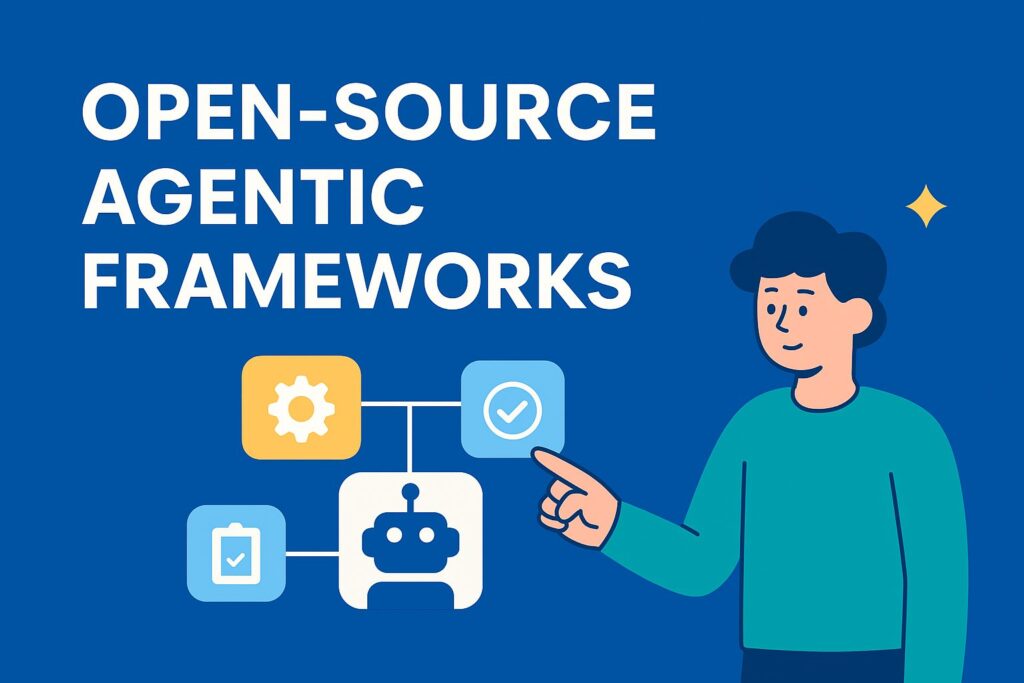When I first began to dabble in agentic AI, I assumed I would find passive-agentic wrappers around large language models (LLMs). But the more I dug into it, the more I saw how much variety and philosophy lie behind these frameworks.
Over the last few weeks, I rolled up my sleeves and tested a set of well-known and emerging open-source agentic frameworks, not just by reading their documentation, but by actually building small demos and seeing where things worked and where they broke.
In this article, I’ll also walk you through what I discovered about LangGraph, Agno, Atomic Agents, SmolAgents, Mastra and PydanticAI, and how they measure up to bigger names such as CrewAI and AutoGen. I’m not rating these; I just want to share what it feels like to develop with each.

Why Agentic Frameworks Matter?
Agentic AI means providing LLMs with the structure and tools to actually do stuff. An LLM by itself can respond to queries; start asking it to talk to APIs, serve up live data, or keep track of state over the course of several steps, and you quickly hit walls.
That’s where these frameworks come in, filling the gap between the problems of today and the ever-expanding front line of AI trends and how intelligent systems are going to work.
That’s where these frameworks step in. They help with:
- Prompt Accuracy → making sure the model gets the right instructions in the right structure.
- Tool calling → routing outputs into APIs, functions, or other resources.
- Memory/state → allowing an agent to “remember” what happened earlier in the process.
- RAG (retrieval-augmented generation) → pulling in knowledge from databases or documents.
- Error handling & observability → making debugging less of a nightmare.
Some frameworks give you a package of tools and obscure the nitty-gritty. The rest give you only the skeleton, and you are on your own to wire everything together. Both have upsides and downsides, and testing them back to back showed me that in stark light.
My Take on Each Framework:
CrewAI
CrewAI seems to be the “high-level no-nonsense” candidate. It allows you to get multi-agent systems off the ground without having to muddy your hands with the prompt generation.
The first time I played around with it, I liked how quickly I could get something working.
But the downside is debugging. When an agent bloopered or misused a tool, I ended up wading through an opaque abstraction. For quick prototyping, it’s excellent. For production, I’d desire more transparency.
AutoGen
AutoGen is in a league of its own; it’s architected around autonomous, asynchronous agent collaboration. The agents, who you can almost see as a team, you unleash, and they are figuring things out.
It was enjoyable to see AutoGen agents “talking” through steps, but the uncertainty of it made me twitchy.
AutoGen is ideal if you’re experimenting or studying emergent behaviors. If you’re standing up a business process and that process has to be exact every single time through, it’s a little bit of a tougher sell.
LangGraph
LangGraph resonated with me when I stopped thinking it would “just work” for my needs and started behaving like an engineering toolkit.
You define workflows as graphs: nodes, edges, managers. Sturdy when it comes to constructing sophisticated multi-agent systems with visibility into all connections.
That doesn’t mean the learning curve isn’t real. I had to rewrite portions of its out-of-the-box flows just to figure out what the hell was going on.
But once I figured it out, I could understand why people continue to use it: It is a blank slate for serious projects.
Agno (formerly Phi-Data)
Agno did impress me, in a positive way as a open-source agentic frameworks. The documentation is clear, the abstractions feel right, and I was able to get a simple RAG + tool-calling system up and running in under an hour.
It feels very modern and developer-friendly, especially compared to the others.
Only the in-depth analysis of multi-agent orchestrations was missing. The feature is there, but it is still getting perfected. However, for the solo agents and clean integration, Agno is definitely one of the ones I like the best.
SmolAgents
SmolAgents is refreshingly minimal. Rather than driving JSON schemas for tool calls, it routes via code with a “CodingAgent”. This makes it ultra-lightweight and also allows direct access to Hugging Face’s gargantuan model library.
When it worked, it was slick. When it didn’t, it became messy to debug with code outputs. For fast experiments with your own or local models, though, there’s something to be said for SmolAgents.
Mastra
Mastra is developed for frontend devs. If you’re already a denizen of the JavaScript ecosystem, it’s a very logical sensation moving on from embedding agents in web apps.
The catch? It’s a little opinionated towards web stuff. If you are into backend-heavy orchestration, you might need more than what Mastra offers.
PydanticAI
For type safety and predictable, validated outputs, Pydantic, even for the most complex code base(I have used it in the most complex one I could think of), feels like home. Using Pydantic, it guarantees responses conform to your schema or, failing that, fail soft.
This rigor saved me time when I cared about stability. The tradeoff is that you end up having to wire more of the orchestration logic on your own. But in situations where correctness is important (like finance or medical apps), that’s a trade worth making.
Atomic Agents
Atomic Agents reminded me of Lego. It’s all schema-driven, and you wire blocks up as you please. The irritation with “black-box” abstractions that fueled the creation of the framework is palpable.
For me, it struck a nice balance between being structured enough to keep things organized, but transparent enough to debug without pulling my hair out. Just expect to engage in more manual orchestration if your system becomes complex.
Also Read: How I Found The Only ChatGPT Prompt That Matters
What Are The Key differences I Noticed?
By implementing and testing a number of these open-source frameworks, I identified three primary dimensions in which the frameworks varied:
- Abstraction level
- High-abstraction: CrewAI, Agno, Mastra (fast to start, harder to debug).
- Low-abstraction: PydanticAI, Atomic Agents, SmolAgents (transparent but requires more work).
- Hybrid: LangGraph sits somewhere in the middle.
- Agency philosophy
- AutoGen and SmolAgents assume agents can act semi-independently.
- PydanticAI, Atomic Agents, and LangGraph prefer tight control.
- Agno and CrewAI land in between.
- Ease of use
- Easiest to get started: Agno, Mastra, CrewAI.
- Tougher but more flexible: LangGraph, PydanticAI, Atomic Agents.
- Novel but experimental: AutoGen, SmolAgents.
What I Learned From These Open-Source Agentic Frameworks?
- Always check the system prompt: if you can’t access or modify it, switching LLMs later will hurt.
- Guard against loops: more than once, I had agents “thinking” forever. Set max steps.
- Validation saves sanity: frameworks like PydanticAI show the value of schema checks.
- Observability is underrated: logs and state inspection should be non-negotiable.
My Recommendations
- For beginners or quick demos → Agno or Mastra.
- For research on multi-agent behavior → AutoGen or LangGraph.
- For production-grade reliability → PydanticAI or Atomic Agents.
- For local/offline model experiments → SmolAgents.
FAQs
Not entirely. Even if a lot of these repetitive jobs can be automated, human creativity, judgment, and emotional intelligence won’t go obsolete. AI will transform job roles, not simply eliminate them.
Healthcare, finance, manufacturing, transportation, and education are likely to see the biggest AI-driven transformation by 2030.
Yes, if regulated properly. But, without robust policy, problems can occur around data privacy, bias, and security risk.
By mastering new skills such as data analysis, prompt engineering, social promotion, AI tooling, and soft skills like communication and problem-solving.
It can do both. AI will make our lives easier, allow for advancements in healthcare and increase productivity, but it also brings ethical and privacy concerns that must be contended with.
Final thoughts
Working across these Open-Source Agentic Frameworks gave me a better appreciation of the tradeoffs in agentic AI. There is not one “best” tool; it depends on whether you prioritize speed, control or reliability.
For me, I was repeatedly returning to Agno when I wanted simplicity and even mindfulness, and to PydanticAI when I wanted reliability. LangGraph wowed me with its flexibility, but it also began to require more patience.
If you’re contemplating taking the plunge into agent frameworks, my advice is: don’t just read the docs. Pick one, make a little thing, and see what it feels like. Experience will tell you more than any feature list ever can.

